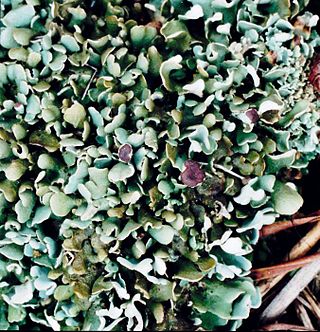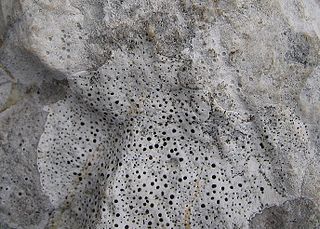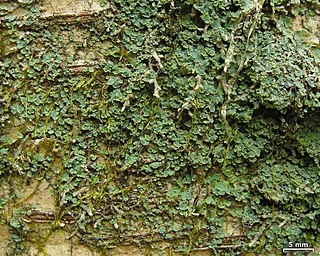
The Clavulinaceae are a family of fungi in the order Cantharellales. The family is not well defined, but currently comprises species of clavarioid fungi as well as some corticioid fungi. These species are nutritionally diverse, some being ectomycorrhizal, others wood-rotting saprotrophs, others lichenized, and yet others lichenicolous.

Lecanoromycetes is the largest class of lichenized fungi. It belongs to the subphylum Pezizomycotina in the phylum Ascomycota. The asci of the Lecanoromycetes most often release spores by rostrate dehiscence.

The Arthoniales is the second largest order of mainly crustose lichens, but fruticose lichens are present as well. The order contains around 1500 species, while the largest order with lichenized fungi, the Lecanorales, contains more than 14000 species.

Verrucariales is an order of ascomycetous fungi within the subclass Chaetothyriomycetidae of the class Eurotiomycetes. Although most of the Verrucariales are lichenised, the family Sarcopyreniaceae consists of 11 species of lichenicolous (lichen-dwelling) fungi.

Verrucariaceae is a family of lichens and a few non-lichenised fungi in the order Verrucariales. The lichens have a wide variety of thallus forms, from crustose (crust-like) to foliose (bushy) and squamulose (scaly). Most of them grow on land, some in freshwater and a few in the sea. Many are free-living but there are some species that are parasites on other lichens, while one marine species always lives together with a leafy green alga.

Tremella is a genus of fungi in the family Tremellaceae. All Tremella species are parasites of other fungi and most produce anamorphic yeast states. Basidiocarps, when produced, are gelatinous and are colloquially classed among the "jelly fungi". Over 100 species of Tremella are currently recognized worldwide. One species, Tremella fuciformis, is commercially cultivated for food.
Bellemerella is a genus of fungi in the family Verrucariaceae. All four species are lichenicolous, meaning they grow parasitically on other lichens.

Heteroplacidium is a genus of lichen-forming fungi in the family Verrucariaceae. The genus was circumscribed by Austrian lichenologist Othmar Breuss in 1996 with Heteroplacidium imbricatum assigned as the type species. It was proposed as a segregate of Catapyrenium. Other morphologically similar genera are Neocatapyrenium, Placidium, and Scleropyrenium, although molecular phylogenetic analyses indicate that they are independent monophyletic lineages within the Verrucariaceae.
Gyrophthorus is a genus of lichenicolous (lichen-dwelling) fungi in the phylum Ascomycota. The relationship of this taxon to other taxa within the phylum is unknown, and it has not yet been placed with certainty into any class, order, or family. The genus was circumscribed in 1990 by Josef Hafellner and Leopoldo Sancho, with Gyrophthorus perforans assigned as the type species.

Normandina is a genus of lichen-forming fungi in the family Verrucariaceae. It has five species of crustose and squamulose (scaly) lichens.

Marchandiomyces is a genus of fungi in the family Corticiaceae.

A lichenicolous fungus' (from Latin -cola 'inhabitant'; akin to Latin colere 'to inhabit') is a parasitic fungus that only lives on lichen as the host. A lichenicolous fungus is not the same as the fungus that is the component of the lichen, which is known as a lichenized fungus. They are most commonly specific to a given fungus as the host, but they also include a wide range of pathogens, saprotrophs, and commensals. It is estimated there are 3000 species of lichenicolous fungi. More than 1800 species are already described among the Ascomycota and Basidiomycota. More than 95% of lichenicolous fungi described as of 2003 are ascomycetes, in 7 classes and 19 orders. Although basidiomycetes have less than 5% of lichenicolous lichen species, they represent 4 classes and 8 orders. Many lichenicolous species have yet to be assigned a phylogenetic position as of 2003.
Briancoppinsia is a fungal genus in the family Arthoniaceae. It is monotypic, containing the single species Briancoppinsia cytospora, a lichenicolous fungus that parasitises parmelioid lichens, as well as Cladonia, Lepra, and Lecanora conizaeoides, among others. The species was first described scientifically by Léon Vouaux in 1914 as Phyllosticta cytospora. The genus was circumscribed in 2012 by Paul Diederich, Damien Ertz, James Lawrey, and Pieter van den Boom. The genus was named for Brian John Coppins, who is, according to the authors, an "eminent British lichenologist and expert of lichenicolous fungi".

Leprocaulaceae is a family of mostly lichen-forming fungi. It is the single family in the monotypic order Leprocaulales. Leprocaulaceae contains three genera and about 33 species.
Xenonectriella subimperspicua is a species of lichenicolous fungus in the family Nectriaceae. It has been recorded from South America, Europe, and New Zealand.
Zhurbenkoa is a genus of lichenicolous fungi in the family Malmideaceae. It has three species. The genus was circumscribed in 2019 by Adam Flakus, Javier Etayo, Sergio Pérez-Ortega, and Pamela Rodriguez-Flakus, with Zhurbenkoa epicladonia assigned as the type species. Closely related genera are Savoronala and Sprucidea. The generic name honours Russian lichenologist Mikhail Zhurbenko, "for his magnificent contribution to knowledge on the biodiversity and systematics of lichenicolous fungi, including lichen parasites colonizing Cladonia".
Capronia suijae is a species of lichenicolous fungus in the family Herpotrichiellaceae. Found in Belarus, it was formally described as a new species in 2017 by Andrei Tsurykau and Javier Etayo. The type specimen was collected from Ostrozhanka Village where it was found growing on the thallus of the bark-dwelling, crustose lichen Xanthoria parietina; Muellerella lichenicola was also simultaneously parasitizing the lichen. Capronia suijae is only known to occur at the type locality. The species epithet suijae honours Estonian lichenologist Ave Suija, "in recognition of her important contribution to the knowledge of lichenicolous fungi".

Thelomma santessonii, the tan nipple lichen, is a species of saxicolous (rock-dwelling), crustose lichen in the family Caliciaceae. Found in northern North America, it was formally described as a new species in 1976 by lichenologist Leif Tibell. It is endemic to the coast and islands of Southern California and Baja California in Mexico.

Hobsonia is a genus of fungi in the family Phleogenaceae. The genus is currently monotypic, with a single recognized species, Hobsonia mirabilis. The type species, H. gigaspora, and H. ackermannii are considered to be synonyms and additional lichenicolous species have now been transferred to the ascomycete genera Hobsoniopsis and Illosporiopsis. Hobsonia mirabilis is only known in its anamorph form, which is whitish, gelatinous, pustular, and occurs on dead woody plant remains. Microscopically, it produces coiled or spiralled conidia. The species was formerly of uncertain disposition, but molecular research, based on cladistic analysis of DNA sequences, has shown that it belongs within the Atractiellales. Though originally described from New York, the species is more commonly found in the tropics and subtropics.

Imshaugia aleurites, commonly known as the salted starburst lichen, is a species of foliose lichen in the family Parmeliaceae. It has a wide distribution in Europe and North America, and has also been recorded in China.















